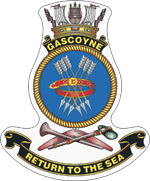HMAS Gascoyne (K354)
| 50x40px | This article includes a list of references, related reading or external links, but its sources remain unclear because it lacks inline citations. Please improve this article by introducing more precise citations where appropriate. (April 2009) |
| Career (Australia (RAN)) | |
|---|---|
| Namesake: | Gascoyne River |
| Builder: | Morts Dock and Engineering Company |
| Laid down: | 3 July 1942 |
| Launched: | 20 February 1943 |
| Commissioned: | 18 November 1943 |
| Decommissioned: | 12 April 1946 |
| Recommissioned: | 8 June 1959 |
| Decommissioned: | 1 February 1966 |
| Reclassified: | Oceanographic Research Ship |
| Motto: | "Return to the Sea" |
| Honours and awards: |
Battle honours: New Guinea 1944 Leyte Gulf 1944 Lingayen Gulf 1945 Pacific 1945[1] |
| Fate: | Sold for scrap in 1962 |
| Badge: |
 |
| General characteristics | |
| Class and type: | River class frigate |
| Displacement: | 1,489 tons (standard), 2,120 tons (full load) |
| Length: | 301 ft 6 in (91.90 m) |
| Beam: | 36 ft 7.75 in (11.1697 m) |
| Draught: | 12 ft (3.7 m) |
| Propulsion: | Triple expansion, 2 shafts. 5,500 hp |
| Speed: | 20 knots (37 km/h) |
| Complement: | 140 |
| Armament: | 2 × 4-inch guns, 2 × 40 mm Bofors, 6 × 20 mm Oerlikons, 1 × Hedgehog, depth charge throwers |
HMAS Gascoyne (K354/F354/A276) was a River class frigate that served in the Royal Australian Navy (RAN). Laid down in 1942 and commissioned in 1943, the frigate served during World War II, before being placed in reserve in 1946. Reactivated in 1959, Gascoyne was reclassified as a survey and research ship, a role she fulfilled until she was decommissioned again in 1966, and sold for scrap in 1972
Construction
Gascoyne was laid down by Morts Dock and Engineering Company in Balmain, New South Wales on 3 July 1942. She was launched on 20 February 1943 by Lady Wakehurst, wife of the Governor of New South Wales, and commissioned into the RAN on 18 November 1943. The ship was named after the Gascoyne River.
Operational history
Gascoyne was present in Tokyo Bay on Victory over Japan Day (2 September 1945), when the Japanese Instrument of Surrender was signed. [2]
Gascoyne paid off into reserve on 12 April 1946, but recommissioned at Sydney on 8 June 1959 for survey and oceanographic research duty.
Decommissioning and fate
Gascoyne paid off again on 1 February 1966, and was sold for scrap to the Fujita Salvage Company Limited of Osaka in Japan on 15 February 1972. The ship left Melbourne under tow for Japan on 6 July 1972.
References
- ↑ Festberg, Alfred N. (1981). Heraldry in the Royal Australian Navy. Melbourne, VIC: Silverleaf Publishing. p. 42. ISBN 0949746002. OCLC 9780949746009.
- ↑ "Allied Ships Present in Tokyo Bay During the Surrender Ceremony, 2 September 1945". Naval Historical Center - U.S. Navy. 27 May 2005. http://www.history.navy.mil/faqs/faq69-2.htm. Retrieved 2007-01-13. "Taken from Commander in Chief, U.S. Pacific Fleet and Pacific Ocean Areas (CINCPAC/CINCPOA) A16-3/FF12 Serial 0395, 11 February 1946: Report of Surrender and Occupation of Japan"
| 40px | This article about a specific Australian naval ship or boat is a stub. You can help Ship Spotting World by expanding it. |
- Pages with broken file links
- Articles lacking in-text citations from April 2009
- Articles with invalid date parameter in template
- All articles lacking in-text citations
- Ship infoboxes without an image
- River class frigates of the Royal Australian Navy
- Frigates of the Royal Australian Navy
- Royal Australian Navy survey ships
- Ships at the Japanese Instrument of Surrender
- 1943 ships
- Australian naval ship stubs
